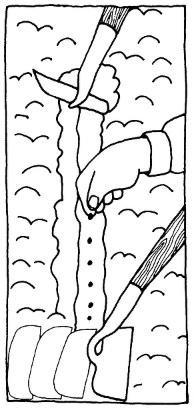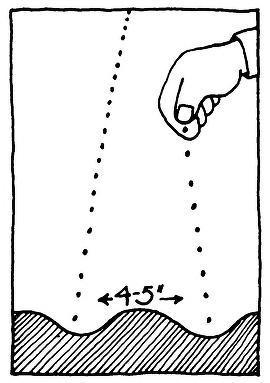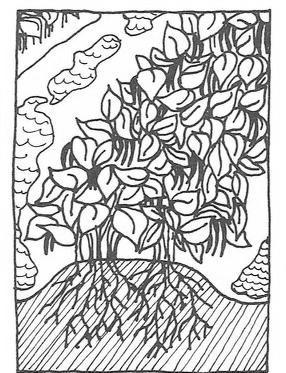For years, many gardeners have planted their bush bean seeds in single-file, straight-line rows with lots of room between the rows. However, some gardeners consider this method a waste of valuable growing space and not the most productive way to grow beans.
Instead, these gardeners use a wide-row technique that allows them to double and sometimes even triple their bean crops. With this method, you simply spread seeds over a wide seedbed, instead of putting one seed behind another in a row. The wide area contains many more plants than a single row of the same length, so you can harvest much more from the same area.
A row 16 to 18 inches across - about the width of a rake head - is very easy to plant, care for and harvest. With a little wide-row experience, you may want to try even wider rows.
 Why Wide-Row?
Why Wide-Row?The advantages to wide-row growing are many.
Stake out a row 15 to 18 inches wide (or wider if you like) and whatever length you want. Drop the seeds three to four inches apart from each other in all directions in the row. One two-ounce package of snap beans covers roughly 10 feet of rake-width row. Firm the seeds into the soil with the back of a hoe, and cover the seeds with about an inch of soil. Using a rake, pull the soil from the side of the row and smooth it evenly over the seeds. Firm the soil again with the back of a hoe.
Leave a path or walkway wide enough to walk on once the plants have grown and spread out. You'll need at least 16 inches, and more if your cultivator or tiller is wider.
Remember, wide rows work well for all beans except the pole varieties.
Single Row MethodSingle row is another planting method to use. The best way to plant a single row is to make a shallow furrow with a hoe. Drop in a bean seed every three to four inches, cover the furrow with one inch of soil and then firm it. A two-ounce packet of bush snap bean seeds sows a single row 30 to 40 feet long.

Make two shallow furrows four to five inches apart, and plant in the same manner as for a single row. This arrangement is especially handy if you need to irrigate regularly. You can put a soaker hose - a kind of garden hose with tiny holes in it - between the two rows and water the plants quite efficiently.
Another easy irrigating system with the double-row system is to dig an additional shallow furrow in between the two seed rows. Make this channel when you're planting the beans. To water the beans, simply run water down the channel between the two rows of plants.

If you garden where it's very rainy, if your soil stays damp or if you have clay soil, planting in raised beds is a good idea because the soil drains better. Good drainage helps to prevent diseases and warms the soil more quickly early in the season.
Try to build up the seedbed four to six inches above the walkway. To get the most for your extra effort, plant a wide row or at least a double row to guarantee a plentiful harvest.

 Victory Seed Company has all the seeds you want for your best garden in 2024.
Victory Seed Company has all the seeds you want for your best garden in 2024.
For 25 years, the family-owned Victory Seed Company has provided the highest quality vegetable, herb and flower seeds to families across the country. We are passionate about providing you the best seeds available that give excellent germination, robust plants, and the harvest you want. With a catalog of over a thousand varieties, we have everything, and our prices are the kinds that we'd want to pay. We have hundreds of yesterday's heirloom vegetables, as well as today's award winning hybrid selections. Get to know us by visiting our website and browsing through our online vegetable seed catalog.
| 1. Shell Beans |
| 2. Wide Row Planting for Beans ← you're on this article right now |
| 1. Shell Beans |
| 2. Wide Row Planting for Beans ← you're on this article right now |